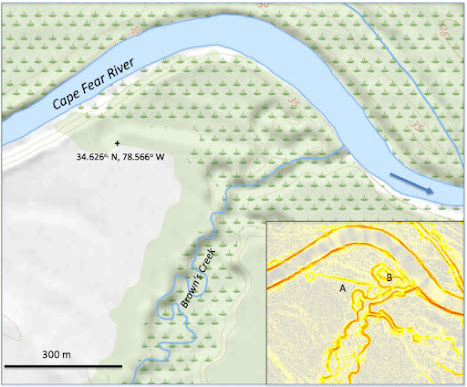Recently Oxford University Press published my first book written for a general readership, as opposed to a scientific research monograph.
The description is below, and you can get it in hardcopy or E-book directly from the publisher here. You can also get it through Amazon, and a free chapter (till May 2026) here.
In one section of the book, I discuss the advantages of high connectivity in environmental systems. “Everything is connected to everything else” is called the First Law of geography, ecology, and environmental science, but why are things so highly connected? For the full answer, read the book. For an illustration of the advantages of high connectivity, I used the lower Waccamaw River, South Carolina—thus my excuse for plugging the book in the Swamp Things blog.
Over a period of slightly less than three years, the lower Waccamaw River experienced the three highest flows ever recorded, during major floods in October 2015, October 2016, and September 2018. In 2015 an “atmospheric river” event pumped moisture from a tropical system well to the south and sent a firehose of wet air into South Carolina, causing extreme rainfall, runoff, and river flooding. Hurricanes Matthew and Florence in 2016 and 2018 included not only extreme river discharges but also storm surges from downstream estuaries. Irrespective of these large, high-energy flows (and in contrast to the severe impacts on humans and the built environment), ecological, geomorphological, and hydrological changes were minimal. The Waccamaw took a lickin’ and kept on tickin.’
Myrtle Beach Sun-News photo by Jason Lee of Waccamaw River flooding in Conway, SC on 9 October 2016. Two National Guard soldiers waded through flood waters going door to door to check on residents.
How? Why? Because of the high connectivity among hydrogeomorphic components of the system. Having better sense than to launch my kayak into the teeth of a hurricane, I did not directly observe what was happening in the river valley during the floods, but have made many field observations since. There is also ample aerial imagery—including some during the floods made by the U.S. Geological Survey and the National Oceanic and Atmospheric Administration specifically to assess storm and flood damage. These give a reasonable picture of what was going on at a broad scale, if not a feel for exactly how water flowed through swamps at a specific location.
Based on field observations and imagery, I demarcated the eight types of hydrogeomorphic elements as shown below.
Hydrogeomorphic elements of the lower Waccamaw channel/wetland complex (copy of Table 8.2 from Mysterious Ways).
Observed hydrologic connections and water exchanges among hydrogeomorphic elements of the lower Waccamaw River. Entries represent fluxes from the row to the column element (copy of Table 8.3 from Mysterious Ways).
Not many blank boxes, huh? There is a high degree of interconnectivity in this system, shown diagrammatically below. Almost everything is connected to almost everything else. The exchanges among elements are in all instances two-way, with the net direction of flux depending mainly on river stages and whether they are rising or falling, but also influenced by astronomical tides, local runoff, storm surges, and wind. This enabled the Waccamaw to absorb the flood and storm surge impacts by storing water and delaying flow through wetlands, activating spillways to transport excess water, reverse flows in some components, and conduct two-way exchanges of water during rising and falling river flows.
Connectivity graph for hydrogeomorphic elements and water exchanges in the lower Waccamaw (Figure 8.6 from Mysterious Ways).
The book gives some additional analysis, but beyond a demonstration of the benefits of connectivity, there is an important lesson about how vital it is to preserve the complex of swamps, back-channels, and other features of these lower coastal plain rivers.























